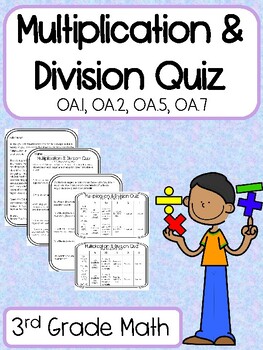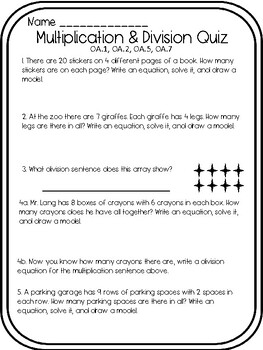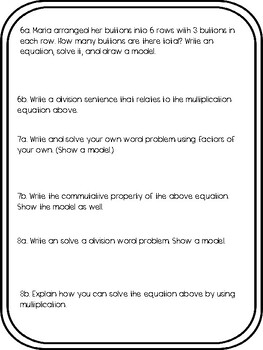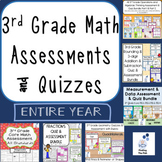Multiplication & Division Quiz with Rubric
Finding the Fish
180 Followers
Grade Levels
3rd, Homeschool
Subjects
Resource Type
Standards
CCSS3.OA.A.1
CCSS3.OA.A.2
CCSS3.OA.B.5
CCSS3.OA.C.7
CCSS3.OA.D.8
Formats Included
- PDF
Pages
6 pages
Finding the Fish
180 Followers
What educators are saying
This is a wonderfully fun and engaging way for my students to learn their multiplication and division facts! Highly recommend!
I used this with my youngest by sending it to their laptop to help boost their multiplication and division skills. Easy to use and excellent outcomes, thank you!
Also included in
- This packet covers the 3rd grade curriculum for Operations and Algebraic Thinking standards OA.1, OA.2, OA.3, OA.4, OA.5, OA.6 and MD.7a, 7c, and 7d. This packet covers the basic skills of multiplying and dividing. Included is a pre/post assessment and 5 different quizzes to assess your students undPrice $7.60Original Price $9.50Save $1.90
- MULTIPLICATION & DIVISION FOR 3RD GRADE ASSESSMENT!This has everything you need to assess your students on their knowledge of multiplication and division. There are arrays, fact families, square numbers, two step equations, area, and more. Students will show their mastery on multiplication and dPrice $13.50Original Price $18.00Save $4.50
- This is your go to 3rd grade math assessment bundle. This covers all 3rd grade math core standards. Assess your students ability to multiply and divide single digit numbers, add and subtract triple digit number, and find the area and perimeter of shapes. It also covers identifying and comparing fracPrice $51.60Original Price $64.50Save $12.90
Description
Multiplication and Division quiz for 3rd grade curriculum. This quiz covers core standards OA.1, OA.2, OA.5, and OA.7. This quiz focuses on solving word problems and showing their work. They will solve both multiplication and division word problems and also relate how the multiplication problem correlates to a division problem. This quiz also covers a question on the commutative property.
This quiz comes with a standards based rubric. This is on a scale of 1-4 and each question is tied to a specific standard.
If you enjoyed this product, please leave a review and follow my page Finding the Fish.
Thank you for your download!
Total Pages
6 pages
Answer Key
N/A
Teaching Duration
N/A
Report this resource to TPT
Reported resources will be reviewed by our team. Report this resource to let us know if this resource violates TPT’s content guidelines.
Standards
to see state-specific standards (only available in the US).
CCSS3.OA.A.1
Interpret products of whole numbers, e.g., interpret 5 × 7 as the total number of objects in 5 groups of 7 objects each. For example, describe a context in which a total number of objects can be expressed as 5 × 7.
CCSS3.OA.A.2
Interpret whole-number quotients of whole numbers, e.g., interpret 56 ÷ 8 as the number of objects in each share when 56 objects are partitioned equally into 8 shares, or as a number of shares when 56 objects are partitioned into equal shares of 8 objects each. For example, describe a context in which a number of shares or a number of groups can be expressed as 56 ÷ 8.
CCSS3.OA.B.5
Apply properties of operations as strategies to multiply and divide. Examples: If 6 × 4 = 24 is known, then 4 × 6 = 24 is also known. (Commutative property of multiplication.) 3 × 5 × 2 can be found by 3 × 5 = 15, then 15 × 2 = 30, or by 5 × 2 = 10, then 3 × 10 = 30. (Associative property of multiplication.) Knowing that 8 × 5 = 40 and 8 × 2 = 16, one can find 8 × 7 as 8 × (5 + 2) = (8 × 5) + (8 × 2) = 40 + 16 = 56. (Distributive property.)
CCSS3.OA.C.7
Fluently multiply and divide within 100, using strategies such as the relationship between multiplication and division (e.g., knowing that 8 × 5 = 40, one knows 40 ÷ 5 = 8) or properties of operations. By the end of Grade 3, know from memory all products of two one-digit numbers.
CCSS3.OA.D.8
Solve two-step word problems using the four operations. Represent these problems using equations with a letter standing for the unknown quantity. Assess the reasonableness of answers using mental computation and estimation strategies including rounding.








